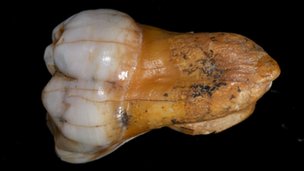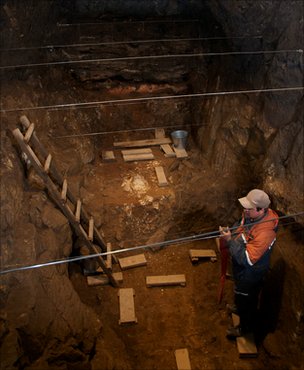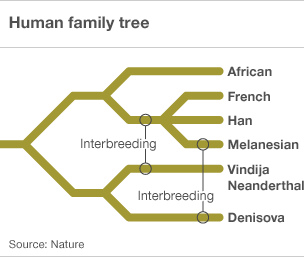December 2010
The ancient humans have been dubbed “Denisovans” after the caves in Siberia where their remains were found. There is also evidence that this population was widespread in Eurasia.
A study in Nature journal shows that Denisovans co-existed with Neanderthals and interbred with other ancestors of the human species – perhaps around 50,000 years ago.
An international group of researchers sequenced a complete genome from one of the ancient hominins (human-like creatures), based on nuclear DNA extracted from a finger bone.
Professor Chris Stringer: “It’s nothing short of sensational – we didn’t know know how ancient people in China related to these other humans”. Scientists say an entirely separate type of human identified from bones in Siberia co-existed and interbred with Neanderthal, Cro Magnon, and others.
According to the researchers, this provides confirmation there were at least four distinct types of human in existence with other races of anatomically modern humans in their African homeland.
Along with modern humans, scientists knew about the Neanderthals and a dwarf human species found on the Indonesian island of Flores nicknamed “The Hobbit”. To this list, experts must now add the Denisovans.
The implications of the finding have been described by Professor Chris Stringer of the Natural History Museum in London as “nothing short of sensational”.
Scientists were able to analyse DNA from a tooth and from a finger bone excavated in the Denisova cave in southern Siberia. The individuals belong to a genetically distinct group of humans that were distantly related to Neanderthals but even more distantly related to the ancestors of Cro Magnon.
The finding adds weight to the theory that a different kind of human could have existed in Eurasia at the same time as other races or species of humo sapiens.
Researchers have had enigmatic fossil evidence to support this view but now they have some firm evidence from the genetic study carried out by Professor Svante Paabo of the Max Planck Institute in Leipzig, Germany.
“A species of early human living in Europe evolved,” according to Professor Paabo. “There was a western form that was the Neanderthal and an eastern form, the Denisovans.”
A study in Nature journal shows that Denisovans co-existed with Neanderthals and interbred with other ancestors of the human species – perhaps around 50,000 years ago.
An international group of researchers sequenced a complete genome from one of the ancient hominins (human-like creatures), based on nuclear DNA extracted from a finger bone.
Professor Chris Stringer: “It’s nothing short of sensational – we didn’t know know how ancient people in China related to these other humans”. Scientists say an entirely separate type of human identified from bones in Siberia co-existed and interbred with Neanderthal, Cro Magnon, and others.
According to the researchers, this provides confirmation there were at least four distinct types of human in existence with other races of anatomically modern humans in their African homeland.
Along with modern humans, scientists knew about the Neanderthals and a dwarf human species found on the Indonesian island of Flores nicknamed “The Hobbit”. To this list, experts must now add the Denisovans.
The implications of the finding have been described by Professor Chris Stringer of the Natural History Museum in London as “nothing short of sensational”.
Scientists were able to analyse DNA from a tooth and from a finger bone excavated in the Denisova cave in southern Siberia. The individuals belong to a genetically distinct group of humans that were distantly related to Neanderthals but even more distantly related to the ancestors of Cro Magnon.
The finding adds weight to the theory that a different kind of human could have existed in Eurasia at the same time as other races or species of humo sapiens.
Researchers have had enigmatic fossil evidence to support this view but now they have some firm evidence from the genetic study carried out by Professor Svante Paabo of the Max Planck Institute in Leipzig, Germany.
“A species of early human living in Europe evolved,” according to Professor Paabo. “There was a western form that was the Neanderthal and an eastern form, the Denisovans.”
Ancient humans, dubbed ’Denisovans’, interbred with us
By Pallab Ghosh | BBC.co.uk
Scientists say an entirely separate type of human identified from bones in Siberia co-existed and interbred with our own species. The ancient humans have been dubbed Denisovans after the caves in Siberia where their remains were found. There is also evidence that this group was widespread in Eurasia.
A study in Nature journal shows that Denisovans co-existed with Neanderthals and interbred with our species - perhaps around 50,000 years ago.
An international group of researchers sequenced a complete genome from one of the ancient hominins (human-like creatures), based on nuclear DNA extracted from a finger bone.
’Sensational’ find
A study in Nature journal shows that Denisovans co-existed with Neanderthals and interbred with our species - perhaps around 50,000 years ago.
An international group of researchers sequenced a complete genome from one of the ancient hominins (human-like creatures), based on nuclear DNA extracted from a finger bone.
’Sensational’ find
According to the researchers, this provides confirmation there were at least four distinct types of human in existence when anatomically modern humans (Homo sapiens sapiens) first left their African homeland.
Along with modern humans, scientists knew about the Neanderthals and a dwarf human species found on the Indonesian island of Flores nicknamed The Hobbit. To this list, experts must now add the Denisovans.
The implications of the finding have been described by Professor Chris Stringer of the Natural History Museum in London as "nothing short of sensational".
Scientists were able to analyse DNA from a tooth and from a finger bone excavated in the Denisova cave in southern Siberia. The individuals belonged to a genetically distinct group of humans that were distantly related to Neanderthals but even more distantly related to us.
The finding adds weight to the theory that a different kind of human could have existed in Eurasia at the same time as our species.
Researchers have had enigmatic fossil evidence to support this view but now they have some firm evidence from the genetic study carried out by Professor Svante Paabo of the Max Planck Institute in Leipzig, Germany.
"A species of early human living in Europe evolved," according to Professor Paabo. "There was a western form that was the Neanderthal and an eastern form, the Denisovans."
The study shows that Denisovans interbred with the ancestors of the present day people of the Melanesian region north and north-east of Australia. Melanesian DNA comprises between 4% and 6% Denisovan DNA.
David Reich from the Harvard Medical School, who worked with Svante Paabo on the study, says that the fact that Denisovan genes ended up so far south suggests they were widespread across Eurasia: "These populations must have been spread across thousands and thousands of miles," he told BBC News.
One mystery is why the Denisovan genes are unique in modern Melanesians and are not found in other Eurasian groups that have so far been sampled.
[...]

DNA from a tooth (pictured) and a finger bone show the Denisovans were a distinct group

The remains were excavated at a cave site in southern Siberia

Read the full article at: bbc.co.uk
Also tune into
- Andrew Collins - Giza’s Cave Underworld Update
- Robert Bauval - Black Genesis & The Ancient People of Nabta Playa
- Klaus Schmidt - Göbekli Tepe: The World’s Oldest Temple?
- Lloyd Pye - Human Origins, Intervention Theory & Genetic Experimentation
- Lloyd Pye - The Starchild Skull
- Lloyd Pye - The Annunaki & Genetic Engineering
- Lloyd Pye - Human Design & Properties of Annunaki Genes
- Michael Cremo - Human Devolution
- Pierre Sabak - The Theban Priesthood, Adam & Eve’s Bloodline
- Nigel Kerner - Grey Aliens and the Harvesting of Souls
- Nigel Kerner - The Greys, Genetic Engineering, Bloodlines, Races & DNA
Related
- The brains of human and Neanderthal babies were almost identical
- Study suggests humans mated with Neanderthals
- Human Likely Killed Neanderthal, Weapons Test Shows
- Scientists unravel Neanderthal genome
- Return of the Neanderthals
- Neanderthal, Human Ancestor Could Chat
- Neanderthals: More Advanced Than Thought?
- Some Neanderthals Were Redheads
Article from: articlesafari.com
Source: http://www.redicecreations.com
Sem comentários:
Enviar um comentário